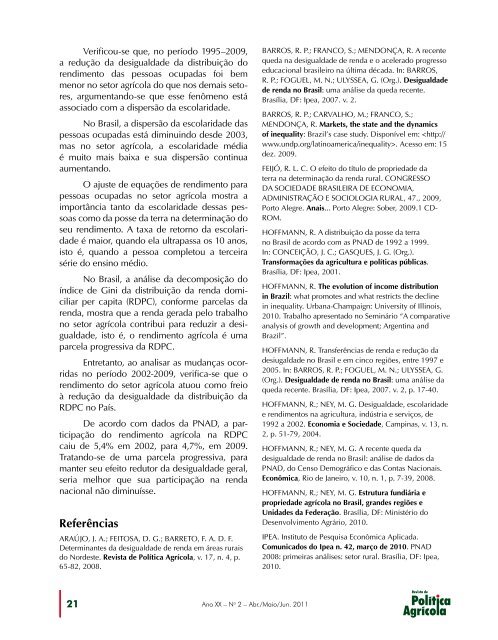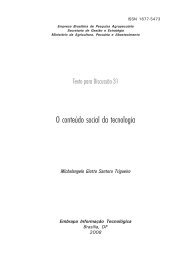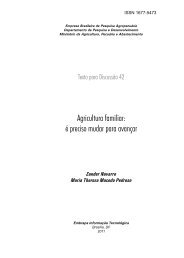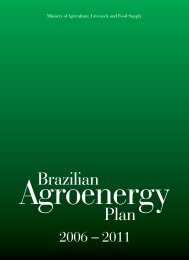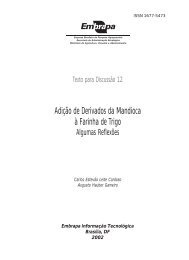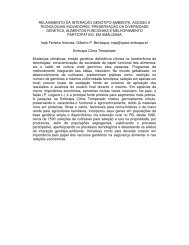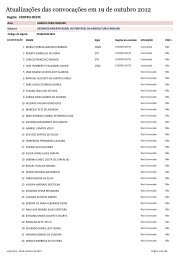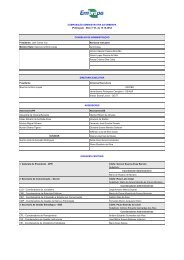Revista de - Ministério da Agricultura
Revista de - Ministério da Agricultura
Revista de - Ministério da Agricultura
Create successful ePaper yourself
Turn your PDF publications into a flip-book with our unique Google optimized e-Paper software.
Verificou-se que, no período 1995–2009,<br />
a redução <strong>da</strong> <strong>de</strong>sigual<strong>da</strong><strong>de</strong> <strong>da</strong> distribuição do<br />
rendimento <strong>da</strong>s pessoas ocupa<strong>da</strong>s foi bem<br />
menor no setor agrícola do que nos <strong>de</strong>mais setores,<br />
argumentando-se que esse fenômeno está<br />
associado com a dispersão <strong>da</strong> escolari<strong>da</strong><strong>de</strong>.<br />
No Brasil, a dispersão <strong>da</strong> escolari<strong>da</strong><strong>de</strong> <strong>da</strong>s<br />
pessoas ocupa<strong>da</strong>s está diminuindo <strong>de</strong>s<strong>de</strong> 2003,<br />
mas no setor agrícola, a escolari<strong>da</strong><strong>de</strong> média<br />
é muito mais baixa e sua dispersão continua<br />
aumentando.<br />
O ajuste <strong>de</strong> equações <strong>de</strong> rendimento para<br />
pessoas ocupa<strong>da</strong>s no setor agrícola mostra a<br />
importância tanto <strong>da</strong> escolari<strong>da</strong><strong>de</strong> <strong>de</strong>ssas pessoas<br />
como <strong>da</strong> posse <strong>da</strong> terra na <strong>de</strong>terminação do<br />
seu rendimento. A taxa <strong>de</strong> retorno <strong>da</strong> escolari<strong>da</strong><strong>de</strong><br />
é maior, quando ela ultrapassa os 10 anos,<br />
isto é, quando a pessoa completou a terceira<br />
série do ensino médio.<br />
No Brasil, a análise <strong>da</strong> <strong>de</strong>composição do<br />
índice <strong>de</strong> Gini <strong>da</strong> distribuição <strong>da</strong> ren<strong>da</strong> domiciliar<br />
per capita (RDPC), conforme parcelas <strong>da</strong><br />
ren<strong>da</strong>, mostra que a ren<strong>da</strong> gera<strong>da</strong> pelo trabalho<br />
no setor agrícola contribui para reduzir a <strong>de</strong>sigual<strong>da</strong><strong>de</strong>,<br />
isto é, o rendimento agrícola é uma<br />
parcela progressiva <strong>da</strong> RDPC.<br />
Entretanto, ao analisar as mu<strong>da</strong>nças ocorri<strong>da</strong>s<br />
no período 2002-2009, verifica-se que o<br />
rendimento do setor agrícola atuou como freio<br />
à redução <strong>da</strong> <strong>de</strong>sigual<strong>da</strong><strong>de</strong> <strong>da</strong> distribuição <strong>da</strong><br />
RDPC no País.<br />
De acordo com <strong>da</strong>dos <strong>da</strong> PNAD, a participação<br />
do rendimento agrícola na RDPC<br />
caiu <strong>de</strong> 5,4% em 2002, para 4,7%, em 2009.<br />
Tratando-se <strong>de</strong> uma parcela progressiva, para<br />
manter seu efeito redutor <strong>da</strong> <strong>de</strong>sigual<strong>da</strong><strong>de</strong> geral,<br />
seria melhor que sua participação na ren<strong>da</strong><br />
nacional não diminuísse.<br />
Referências<br />
ARAÚJO, J. A.; FEITOSA, D. G.; BARRETO, F. A. D. F.<br />
Determinantes <strong>da</strong> <strong>de</strong>sigual<strong>da</strong><strong>de</strong> <strong>de</strong> ren<strong>da</strong> em áreas rurais<br />
do Nor<strong>de</strong>ste. <strong>Revista</strong> <strong>de</strong> Política Agrícola, v. 17, n. 4, p.<br />
65-82, 2008.<br />
21<br />
Ano XX – N o 2 – Abr./Maio/Jun. 2011<br />
BARROS, R. P.; FRANCO, S.; MENDONÇA, R. A recente<br />
que<strong>da</strong> na <strong>de</strong>sigual<strong>da</strong><strong>de</strong> <strong>de</strong> ren<strong>da</strong> e o acelerado progresso<br />
educacional brasileiro na última déca<strong>da</strong>. In: BARROS,<br />
R. P.; FOGUEL, M. N.; ULYSSEA, G. (Org.). Desigual<strong>da</strong><strong>de</strong><br />
<strong>de</strong> ren<strong>da</strong> no Brasil: uma análise <strong>da</strong> que<strong>da</strong> recente.<br />
Brasília, DF: Ipea, 2007. v. 2.<br />
BARROS, R. P.; CARVALHO, M.; FRANCO, S.;<br />
MENDONÇA, R. Markets, the state and the dynamics<br />
of inequality: Brazil’s case study. Disponível em: . Acesso em: 15<br />
<strong>de</strong>z. 2009.<br />
FEIJÓ, R. L. C. O efeito do título <strong>de</strong> proprie<strong>da</strong><strong>de</strong> <strong>da</strong><br />
terra na <strong>de</strong>terminação <strong>da</strong> ren<strong>da</strong> rural. CONGRESSO<br />
DA SOCIEDADE BRASILEIRA DE ECONOMIA,<br />
ADMINISTRAÇÃO E SOCIOLOGIA RURAL, 47., 2009,<br />
Porto Alegre. Anais... Porto Alegre: Sober, 2009.1 CD-<br />
ROM.<br />
HOFFMANN, R. A distribuição <strong>da</strong> posse <strong>da</strong> terra<br />
no Brasil <strong>de</strong> acordo com as PNAD <strong>de</strong> 1992 a 1999.<br />
In: CONCEIÇÃO, J. C.; GASQUES, J. G. (Org.).<br />
Transformações <strong>da</strong> agricultura e políticas públicas.<br />
Brasília, DF: Ipea, 2001.<br />
HOFFMANN, R. The evolution of income distribution<br />
in Brazil: what promotes and what restricts the <strong>de</strong>cline<br />
in inequality. Urbana-Champaign: University of Illinois,<br />
2010. Trabalho apresentado no Seminário “A comparative<br />
analysis of growth and <strong>de</strong>velopment; Argentina and<br />
Brazil”.<br />
HOFFMANN, R. Transferências <strong>de</strong> ren<strong>da</strong> e redução <strong>da</strong><br />
<strong>de</strong>siugal<strong>da</strong><strong>de</strong> no Brasil e em cinco regiões, entre 1997 e<br />
2005. In: BARROS, R. P.; FOGUEL, M. N.; ULYSSEA, G.<br />
(Org.). Desigual<strong>da</strong><strong>de</strong> <strong>de</strong> ren<strong>da</strong> no Brasil: uma análise <strong>da</strong><br />
que<strong>da</strong> recente. Brasília, DF: Ipea, 2007. v. 2, p. 17-40.<br />
HOFFMANN, R.; NEY, M. G. Desigual<strong>da</strong><strong>de</strong>, escolari<strong>da</strong><strong>de</strong><br />
e rendimentos na agricultura, indústria e serviços, <strong>de</strong><br />
1992 a 2002. Economia e Socie<strong>da</strong><strong>de</strong>, Campinas, v. 13, n.<br />
2, p. 51-79, 2004.<br />
HOFFMANN, R.; NEY, M. G. A recente que<strong>da</strong> <strong>da</strong><br />
<strong>de</strong>sigual<strong>da</strong><strong>de</strong> <strong>de</strong> ren<strong>da</strong> no Brasil: análise <strong>de</strong> <strong>da</strong>dos <strong>da</strong><br />
PNAD, do Censo Demográfico e <strong>da</strong>s Contas Nacionais.<br />
Econômica, Rio <strong>de</strong> Janeiro, v. 10, n. 1, p. 7-39, 2008.<br />
HOFFMANN, R.; NEY, M. G. Estrutura fundiária e<br />
proprie<strong>da</strong><strong>de</strong> agrícola no Brasil, gran<strong>de</strong>s regiões e<br />
Uni<strong>da</strong><strong>de</strong>s <strong>da</strong> Fe<strong>de</strong>ração. Brasília, DF: <strong>Ministério</strong> do<br />
Desenvolvimento Agrário, 2010.<br />
IPEA. Instituto <strong>de</strong> Pesquisa Econômica Aplica<strong>da</strong>.<br />
Comunicados do Ipea n. 42, março <strong>de</strong> 2010. PNAD<br />
2008: primeiras análises: setor rural. Brasília, DF: Ipea,<br />
2010.


